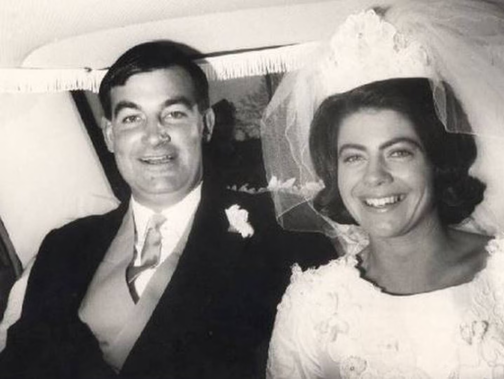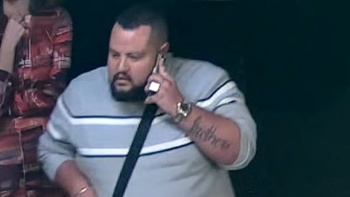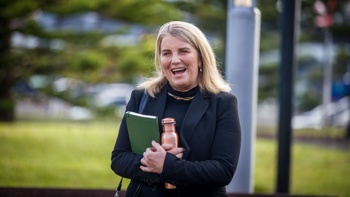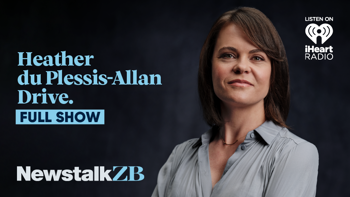
The unsolved murders of Harvey and Jeannette Crewe in 1970 are New Zealand’s most infamous cold case, despite two murder trials, a Royal Commission of Inquiry and a major modern police inquiry. A new book by journalists Kirsty Johnston and James Hollings reveals new evidence and witnesses who have stayed silent for decades. One of those witnesses is Ross Eyre, who speaks publicly for the first time in The Crewe Murders.
When Jeannette and Harvey Crewe were killed, Ross Eyre was 16. Before the murders, he and his disabled brother John Eyre cut hay for Harvey Crewe. Afterwards, John was named as a possible suspect in the murders, first by defence counsel Kevin Ryan, and then by members of the Thomas family.
Ross Eyre remembers the week of the murders clearly, although he is now nearing 70. Ross and his wife Trish still live in Pukekawa, a mile or two down Highway 22 from the Eyre homestead, on the old Brewster farm. Ross is a big, burly man. He wears a Swanndri and gumboots, and has a friendly but watchful smile. He invites us into his kitchen, where two armchairs sit next to a table strewn with papers. The winter sun is bright through the window.
Ross has never told his family’s full story about the Crewe murders to a journalist before, but now he has Parkinson’s disease he’s decided he wants it on the record.
When he was a schoolboy, he told us, he stood on Highway 22 each morning to catch a bus to school. On Thursday or Friday, the day after the Crewes were killed but before anyone knew about it, he was waiting for his school bus at their farm gate, on the corner of Te Ahu Road.
Ross Eyre of Pukekawa, whose key evidence was overlooked by police.
Crewe case: A brother's crusade
“The Crewe car came past. And I waved out like you always do when you know everyone’s cars in those days and this person glared at me, hit the pothole at the corner and nearly drove off the road and tootled off towards Tūākau. And I thought nothing much of it, I thought ‘oh well the Crewes are snobs, she never waved to me’. I remember the dog-ball eyes glaring at me. I told my mum, ‘oh Mrs Crewe is a snob, she never waved to me as they usually do’.”
What Eyre means here, is that he realised that if it had been Jeannette, she would have waved to him, and would have known about the pothole. Thus, thinking it over, he realised the person in the car was not Jeannette Crewe.
/cloudfront-ap-southeast-2.images.arcpublishing.com/nzme/Q3Q7GJXHQUFHB4M52Z6FD6K22Q.jpg)
Harvey and Jeannette Crewe were shot dead in their Pukekawa farmhouse in 1970 then dumped in the Waikato River.
Ross thought nothing of it until the news about the missing couple and the bloodstained house broke on the Monday night. His mother, Ruth, called police to report what Ross had seen.
“Next thing we know a cop comes along. That was Inspector Charles at the time in his fancy suit, smelling of perfume, etc and all dolled up to the nines, and curly hair. He’s pulled his little book out sitting there and I’m sitting here and eating scones and Christmas cake and he said, ‘What did you see, young fulla?’ And I said, ‘I saw the Crewe car’, and he said, ‘That’s not possible, they’ve disappeared’, and I said, ‘No, I saw the Crewe car.’
“He closed his book, never even wrote anything down. ‘You’re a little boy looking for notoriety, aren’t you?’
“My mum was ropeable and ... said, ‘Ross is not a liar. Ross saw the Crewe car either on the Thursday [or] Friday’. I can’t remember now, it was that bloody long ago but Charles didn’t believe me. This is the one thing I have against the police. If they’d listened to me and the Māori boy [the witness] they would have nailed them. And the Crewes knew the pothole. Because they lived out the back and they drove there all the time.”
The Māori witness Ross Eyre is referring to is Tutu Hoeta, a local shearer. He saw a green-and-white two-toned 1964 Valiant parked in front of the Crewe house as he drove past on Saturday 20 June. He remembered the car because he had always wanted one and he remembered what day it was because he won at the TAB that day. He was able to give details of the day and time of his win, which police checked, and they were spot on. He is still alive and living in Pukekohe.
Of all the vehicle sightings, this was perhaps the most significant, because there were known to be only two such cars in the district at the time. One belonged to Anthony Insoll, who lived several miles away at Glen Murray; the other to Richard Thomas. Insoll, although having been in the area on the night of the murders, was never considered a suspect.
A feud in Pukekawa
The six Eyre children grew up near the Crewe farm. Ross is the youngest, and by the time of the Crewe murders, most of his siblings had moved out. But his older brother John was born deaf, so he always lived at home. Ross and John knew Harvey Crewe well, as they worked for him in the summer of 1969, cutting and raking hay.
Ross says Harvey was a good employer and a hard worker, tough but fair. Ross remembers driving the tractor on a steep piece of the Crewe farm, with Harvey. He remembers saying: “This is steep, Mr Crewe, gee it’s steep.” He kept saying, “Nah, you’re all right boy, you’re all right.” He knew Harvey could get worked up, however: Ross had watched him tear strips off the hay-baler driver, telling him the bales weren’t tight enough.
One day after working at the farm late, Ross went to the Crewe house and Jeannette got him a glass of orange drink. “The little girl was there, Rochelle, clinging to her mother. Jeannette went to school with my brothers. She was a nice lady. Pleasant to talk to. She was fairly quiet from my memory of her. I never went in the house, that’s the funny thing. I stood at the steps with little Rochelle there and I drunk my glass of drink at the bottom of the steps.”
In those days, he says, it was normal for children not to be invited in and he didn’t see it as rude. Afterwards, Harvey Crewe took Ross home, and Ruth invited him in for a cup of tea. While Harvey was talking to his father, Annesley Eyre, known as Joff, Ross was listening in. He remembers it clearly. Harvey was wearing a new pair of boots and his father commented on them. “Harvey said, ‘Yeah, things are going pretty well’ and Dad said, ‘They must be with those boots’.” He also heard Harvey say, ‘Don’t get Richard Thomas and Stuckey to do the fencing, they’ve put the fence in the wrong place.’
Six months later, the Crewes were dead. “It was just terrible,” Ross told us. “Absolutely terrible because we knew them and then once they found the bodies they picked all the guns up and then the forensic people made a mistake on Jack’s (Brewster, who was Ross and John’s stepdad) gun.”
Journalist Kirsty Johnston at the Devil's Elbow on the Waikato River, close to where Jeannette Crewe's body was found.
That mistake — incorrectly naming the Eyre rifle as one that could have fired the fatal bullets — was to spark a decades-long feud between the Eyres and Thomases that festers to this day. But that was to come later. In the days and weeks after the Crewe disappearance, most people in the district turned out to search the surrounding farmland, Trish’s father included.
“My father had a boat in Glen Murray,” she said. “He looked in all the caves and the tomo holes. Going up the river with the boat.”
Ross remembered the Army parked at the top of the hill, helping with the search. “People couldn’t believe it, and God you heard all sorts of stories. It was the Americans because of Jeannette’s sister. The Americans had done her in for the inheritance. Then aliens had done it. All the garbage instead of the facts.”
‘Hanging is too good for them’
Later, when Arthur Thomas was arrested, the relationship between the Eyres and the Thomases turned sour. It is a moment that Ross Eyre remembers vividly. “We couldn’t believe it when they found the bodies and then they [said] that Arthur had done it. They tried Arthur and locked him up and with the second trial, Richard and his father came to see us. Old Allan Thomas turned around to Mum and said, ‘Ruthie, do you think Arthur did it?’ and she said, ‘No, I don’t think Arthur did it but whoever did, hanging is too good for them’.”
At that, Ross claims, Richard Thomas clenched his fists. A friend of the family, Lynette Ramsey, was at one end of the table, Ross was at the other, he says, and Richard was in the middle. “Richard pushed the chair from under him, clenched his fists and he was white and said to his father, ‘Dad, we’ve got to go’, and since that day they’ve put the boot into us. And Mrs Ramsey turned and said to Mum, ‘I think they’ve got the wrong one’. We’ve never believed Arthur did it.”
The arrest of Arthur Thomas split the Pukekawa community into two camps, Ross says. Mostly, it was the Catholics on the Thomas side; the Protestants were neutral, but it divided a lot of families. Ross remembers incidents in town: Once he was there when the jeweller William Eggleton was threatened by a local woman who was a supporter of Arthur Thomas. ‘I told her three times, leave, and I had to physically remove her and she said, “You bastard Eyres, we’re going to get you.”
After the second trial, when Kevin Ryan had named John Eyre as a suspect, and Bruce Roddick (a local farm worker who had testified seeing a woman outside the Crewe house after the murders) told the court he’d seen John be cruel to animals, many of Thomas’s supporters turned on the Eyres.
/cloudfront-ap-southeast-2.images.arcpublishing.com/nzme/RIJKUSJJHRXLU7YPPIVG3TVEGM.jpg)
Auckland Star journalist Pat Booth (right) and Arthur Allan Thomas after his release from prison as a result of a pardon. Booth's campaigning journalism was a key part of exposing the flawed police case against Thomas.
“I was walking down the main street and different ones I went to school with spat in my face and said, ‘You’re just a pack of murdering bastards and you got away with it, it was nothing to do with the Thomases’.”
Things deteriorated further as some of the Thomases and their supporters became convinced John Eyre was the murderer, and that it was being covered up by his family. (Pukekawa local) John Martin gave an affidavit that Richard Thomas got him to cut copper wire out of the Eyre clothesline to give to the defence to analyse to see if it matched the wire found on the bodies.
According to Ross Eyre, that wasn’t the only intrusion on to their property in the years after the second trial. On one occasion, the family were out on a Friday night and when they got home a neighbour called to say that one of the Thomases had been going through their shed and the house.
Another night, they were having dinner and looked outside to see a glow in the tree, a light going up and down, like someone puffing on a cigarette. ‘So I went and got my gun, grandad’s old shotgun, put two shells in my pocket and went out the back. The bugger heard me open the door, so I let rip and I ran down the driveway,’ Ross told us. ‘Next day the police rang up and said, “Tell the young fella to pull his head in”, and Mum said, “What do you mean? He was shooting at possums.”’
‘He’s the bastard that did it’
The Thomas theory was that John Eyre had cut the wrong paddock of hay at Harvey Crewe’s farm, and they’d had a row, which is why John killed the Crewes, he says. “Which is balderdash, because I raked the hay. And Dad did the accounts — we didn’t even get paid. We did it because we were Dad’s kids.”
Plus, Ross says, he knows Harvey Crewe was pleased with the job because he said he would have them back the next year to do the hay again.
Ross says he believes he was targeted because he stood up for his brother, and that Richard Thomas was trying to take the heat off himself. ‘I’ve had a shotgun put under my nose and [had somebody] say, “Admit it you bastard or we’re going to blow you away” ... that was John Martin again.
/cloudfront-ap-southeast-2.images.arcpublishing.com/nzme/WZ3AAZIDQJFVROQM2BEIONTRMA.jpg)
Journalist James Hollings with the axle found with Harvey Crewe's body that became a key focus of police inquiries.
“I said, ‘What are you doing, Speedy?’ and he said, ‘Richard wants to get the information out of you’. I said, ‘Piss off, he did it. He’s the bastard that did it, not Johnny’.”
Ross claims it was Richard who had the argument with Harvey Crewe at the farm, and that it was Richard’s car seen there the Saturday after the killings. Once Ross even put it to Richard that he was the one who killed the Crewes.
“He came up our drive one time and Mum said get rid of him, and I went out and he said to me, ‘You’re the only thing stopping me getting at your mother and Mickey’ (Eyre, who police suspected at one stage and was later ruled out). And I said, ‘Yes, Richard, it wasn’t Arthur, it was you. Now f*** off’, and he just smiled.”
For more than 30 years, the Eyre family did little to push back against the rumours that circulated in Pukekawa. But in 2006, when the Thomas family appeared on TV One’s Sunday programme implying that John Eyre was the Crewe killer, it was the final straw. Ross gave a full statement to the Pukekohe police. He says he did it “just in case anything happened because I was threatened”.
Des Thomas (Arthur Allan Thomas’ brother) had developed a theory that John Eyre had killed the Crewes and the Eyres had the barrel of his Remington .22 rifle modified to hide the evidence. Ross took the gun with him to the police station, saying he was happy to lend it to them for any testing, but he wanted it back when they were finished.
Ross Eyre told police his whole story — about some of the Thomas family coming on to their farm, about his sighting of the woman in the car the week of the murders, about how the police never listened to him. He said since the Sunday programme had aired, the family had been harassed. People had been calling saying, ‘How does it feel to be a murderer and get away with it?’
Police tested the Remington .22 later in 2006. They found the barrel had not been replaced at any time. Ross still has the gun. Police offered to dispose of it, but Ross refused. ‘I said, “Why the hell would I want to dispose of this gun when this gun is the only evidence we’ve got that we didn’t bloody well do it”?’
/cloudfront-ap-southeast-2.images.arcpublishing.com/nzme/MKAZWMNW7L443PVE3NESP57X4Q.jpg)
Detective Inspector Bruce Hutton at the Crewe house during the 1970 murder investigation. He was later accused of planting evidence that led to Arthur Allan Thomas' conviction.
After the tests on the rifle came back, Des Thomas continued to insinuate that John Eyre was responsible for the murders. In 2012, Ross Eyre spoke to two of the police review team, Gary Lendrum and Detective Sergeant Veronica McPherson, who visited his house twice. They found him a credible witness, they reported. He told them about overhearing the conversation about Richard and Buster and the fencing. He told them again about his sighting of the woman in the car. The sighting, of which police never found a record in the original inquiry documents, was listed as ‘new information’ in the report. Ross Eyre says this was the first time he had felt heard by police.
A curse on the Eyre family
The passage of time has dampened the heat of accusations about the Eyre family. The review team’s findings, that John Eyre wasn’t involved, have helped. Ross and Trish Eyre say it didn’t ever affect their daily lives, anyway, although they sometimes worried about the impact on their two daughters, particularly while they were at school.
Ross says he knows without doubt that John did not kill the Crewes, partly because he knows his brother as a kind person, but also because of their family history. Ross and John are grandsons of Sydney Eyre, who was shot dead over 100 years ago at the Eyre homestead. Ross’ father was 9 years old when his own father was killed.
But the family have another story about the murder of his grandfather. Ross says when his father’s older brothers, John and Phil, were young, they found a Māori gravesite on the Eyre property next to the waterfall. A little girl had been buried there. John and Phil took the skull to scare the hell out of their sister.
When he found out, their father was furious. “Put that back where you found it,” he said. But instead of returning it, they threw it over the waterfall. Afterwards, local Māori told the family that there was a curse on the Eyres, and that’s why Sydney died.
It is in part because of this history that Ross Eyre is adamant no one in his family is responsible for the Crewe murders. “If anyone in our family had have done it, Mum would have sent them to the police because of what happened to Grandad.”
Take your Radio, Podcasts and Music with you

/cloudfront-ap-southeast-2.images.arcpublishing.com/nzme/KHOG47JXDRDYZOZCGPPOHJTNTA.JPG)
/cloudfront-ap-southeast-2.images.arcpublishing.com/nzme/HRDCHP7FJZAJNN4SB5YL6NUALM.JPG)








